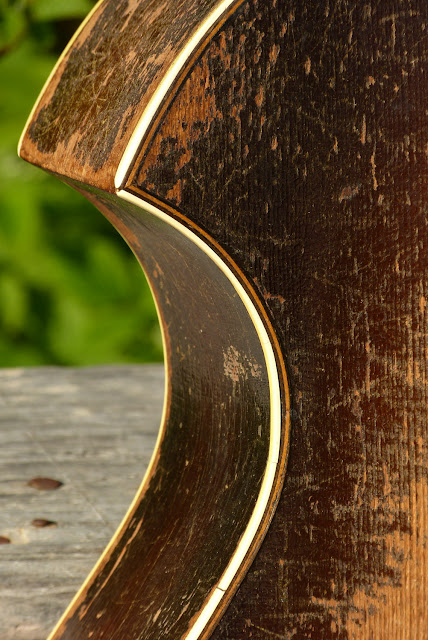1930s Kay Kraft Venetian Archtop Guitar
Doesn't this look pretty in front of our raspberry patch? This here's a 1930s Kay-made, Kay Kraft "venetian" archtop. It's also a 14-fret variant which usually comes ladder-braced, but this one has x-bracing like the earlier 12-fret version. This means, yes, that the sound is a bit more oomphy and less slappy, though it does have tons of that "gypsy-jazz" snappy vibe and sizzle. The tone is almost all mids and highs with just a hint of mwah velvet on the lower strings -- and it has volume and punch in spades.
I really think these are comparable in response and zing to Selmer-Mac guitars when strung with gypsy-jazz silverplated-copper strings -- which this one is wearing, thanks to me strong-arming its owner to try them out (here's looking at you, Mr. I'm-Playing-at-the-Fillmore-in-San-Fran-tonight). It's got Savarez Argentine 11s on it.
Anyhow, this came in relatively good shape over here -- though obviously well-loved (and deservedly-so). It had/has all of its original fittings, though the bakelite bridge wasn't passing muster, the neck angle was a little low, and the frets appear to have been replaced with more modern gauges (thankee, gods). Still -- I did a fret level/dress, modified the neck-attachment area slightly (these are bolted, adjustable necks), checked it all out, fit a new rosewood bridge, and set it up. It's on the dot as regards action, feels nice and springy under the fingers, has a great break angle on the bridge, and feels rock-solid stable.
Like other early-30s round-hole archtops, these are 00 in size with a ~14" lower bout width. That, combined with the easy-access shape of the upper bout, makes an extremely comfortable and compact guitar.
The neck also has a "modern" depth and Martin-ish soft-v shape, but a wider 1 3/4" nut width. The radius on the board is ~12" and that certainly helps to give it a more modern feel.
The body uses ply maple for the back and sides and the top might be ply, too, but I can't be certain just by checking the pickguard-bracket holes in the top. I know that the mandolin versions of these from the same period were ply-topped and that's how they get their distinct pop and sizzle as the top is only 1/16" all around and thus really responds to the strings.
It's hard to knock all the Chicago-fancy trim on these! The pearloid attack at the headstock is bluesy-classy like mad.
The board is rosewood with pearl dots.
How anyone managed to washboard this guitar as much as it has been is shocking. It looks awesome.
The new rosewood bridge is relatively pedestrian but it's a huge improvement in tone and practicality compared to the original bakelite one, which looks like...
...this! Under tension, these tend to collapse or at least bend, which is unfortunate as they're very cool. The underside of the "bridge topper" has a flat-radius saddle shape, too, so that Kay employees could simply flip them over during manufacturing to use on flat-radius fretboards.
This has Kay's bolt-on, adjustable neck gizmo. I find these somewhat useful but they tend to loosen-up and get weird. My solution is to loosen them up, shim the top of the joint/gizmo to the back-angle I want, tighten it up with...
...the big bolt inside, and then install a second screw into the heel below the big bolt to "lock" the neck in the position I want it to stay. This is reversible and invisible on the outside.
Note that the last guy to work on this made the super-smart choice of adding a nylon-insert hex nut and lock washer to the "big old bolt" to make it stay-put better. Still, unfortunately, it needs the second screw/bolt to really stay where you want it. The "dish" of the heel joint just wants to move.
I have extensive knowledge of this frustration when dealing with Kay banjos using the same joint...!




























Comments